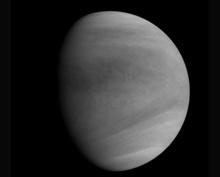Japanese space probe Akatsuki enters Venus orbit on second attempt
11 Dec 2015
Japanese space agency JAXA has successfully brought its Venus probe mission, Akatsuki, back into Venus's orbit, on second attempt, after five years of drifting through space.
 The Akatsuki space probe entered orbit around Venus after a successful last-resort plan to slow it down by igniting the probe's attitude-control engines and using reverse thrust to the full capacity.
The Akatsuki space probe entered orbit around Venus after a successful last-resort plan to slow it down by igniting the probe's attitude-control engines and using reverse thrust to the full capacity.
The Japan Aerospace Exploration Agency (JAXA) said the scientists succeeded in conceiving and implementing this maneuver by harnessing Venus' gravitational pull.
Akatsuki was launched in May 2010 and the probe attempted to enter Venus's orbit six months later by firing its main engine, but ran into trouble when the engine stopped during the operation.
The Venus Climate Orbiter, called Akatsuki after the Japanese word for dawn, was launched on 20 May 2010. It arrived at Venus on 6 December 2010 and began the rocket burn that would place it into a four-day orbit around the planet.
Unfortunately, instead of a 12-minute burn the rocket fired for less than three minutes because of a sticky valve in the engine. So Akatsuki sailed past the planet and off into space again.
JAXA now has the credit of successfully bringing back for the first time a space probe that has swung into the orbit of another planet.
JAXA said `Akatsuki' is circling around Venus. At its current thrust ejection, ''the orbiter is now flying on the elliptical orbit at the apoapsis altitude of about 440,000 km and periapsis altitude of about 400 km from Venus.''
The orbit period is 13 days and 14 hours, JAXAaid, adding that the orbiter is flying in the same direction as that of Venus's rotation.
''The probe is functioning properly,'' JAXA project manager Masato Nakamura said during a press conference, adding that the probe would shift to full observation of Venus in April.
Carrying six types of observation equipment, Akatsuki is designed to study the thick clouds shrouding Venus in three dimensions and how its strong winds, estimated to be faster than 360 kph, cause an atmospheric phenomenon known as super-rotation, in which the atmosphere rotates much faster than the planet.
''We will deploy the three scientific mission instruments namely the 2µm camera (IR2), the Lightning and Airglow Camera (LAC) and the Ultra-Stable oscillator (USO) and check their functions. JAXA will then perform initial observations with the above three instruments along with the three other instruments whose function has already been confirmed, the Ultraviolet Imager (UVI), the Longwave IR camera (LIR), and the 1µm camera (IR1) for about three months.
''At the same time, JAXA will also gradually adjust the orbit for shifting its elliptical orbit to the period of about nine days. The regular operation is scheduled to start in April, 2016,'' the agency said.













.jpg)






.jpg)









